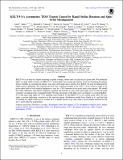KELT-9 b’s Asymmetric TESS Transit Caused by Rapid Stellar Rotation and Spin–Orbit Misalignment
Author(s)
Ahlers, John P; Johnson, Marshall C; Stassun, Keivan G; Colón, Knicole D; Barnes, Jason W; Stevens, Daniel J; Beatty, Thomas; Gaudi, B Scott; Collins, Karen A; Rodriguez, Joseph E; Ricker, George; Vanderspek, Roland; Latham, David; Seager, Sara; Winn, Joshua; Jenkins, Jon M; Caldwell, Douglas A; Goeke, Robert F; Osborn, Hugh P; Paegert, Martin; Rowden, Pam; Tenenbaum, Peter; ... Show more Show less
DownloadPublished version (1.832Mb)
Publisher Policy
Publisher Policy
Article is made available in accordance with the publisher's policy and may be subject to US copyright law. Please refer to the publisher's site for terms of use.
Terms of use
Metadata
Show full item recordAbstract
© 2020. The American Astronomical Society. All rights reserved KELT-9 b is an ultra-hot Jupiter transiting a rapidly rotating, oblate early-A-type star in a polar orbit. We model the effect of rapid stellar rotation on KELT-9 b's transit light curve using photometry from the Transiting Exoplanet Survey Satellite to constrain the planet's true spin-orbit angle and to explore how KELT-9 b may be influenced by stellar gravity darkening. We constrain the host star's equatorial radius to be 1.089 ± 0.017 times as large as its polar radius and its local surface brightness to vary by ∼38% between its hot poles and cooler equator. We model the stellar oblateness and surface brightness gradient and find that it causes the transit light curve to lack the usual symmetry around the time of minimum light. We take advantage of the light-curve asymmetry to constrain KELT-9 b's true spin-orbit angle (87° +10° -11° ) agreeing with Gaudi et al. that KELT-9 b is in a nearly polar orbit. We also apply a gravity-darkening correction to the spectral energy distribution model from Gaudi et al. and find that accounting for rapid rotation gives a better fit to available spectroscopy and yields a more reliable estimate for the star's polar effective temperature.
Date issued
2020-06Department
Massachusetts Institute of Technology. Department of Physics; MIT Kavli Institute for Astrophysics and Space Research; Massachusetts Institute of Technology. Department of Earth, Atmospheric, and Planetary Sciences; MIT Kavli Institute for Astrophysics and Space ResearchJournal
Astronomical Journal
Publisher
American Astronomical Society
ISSN
1538-3881